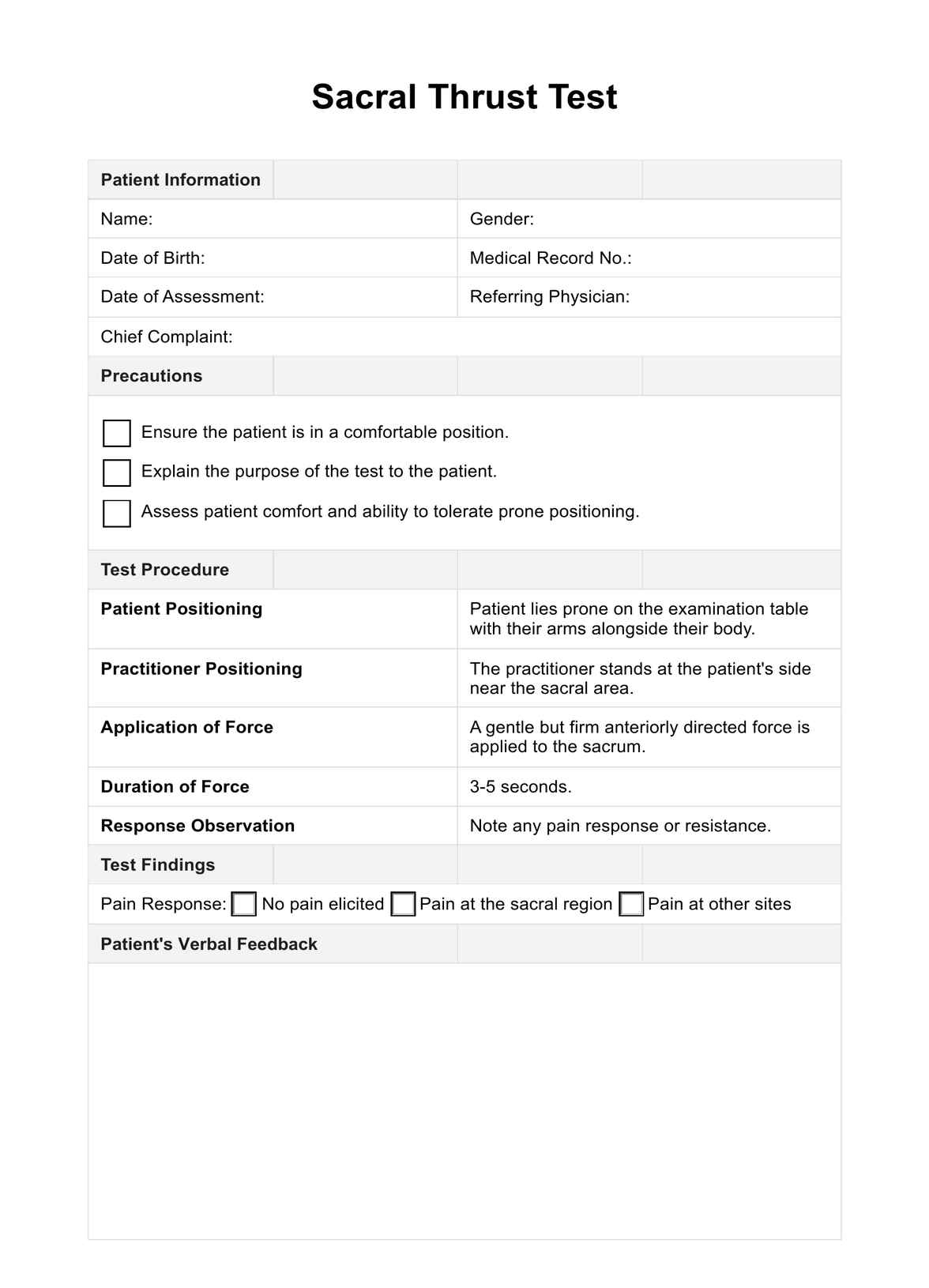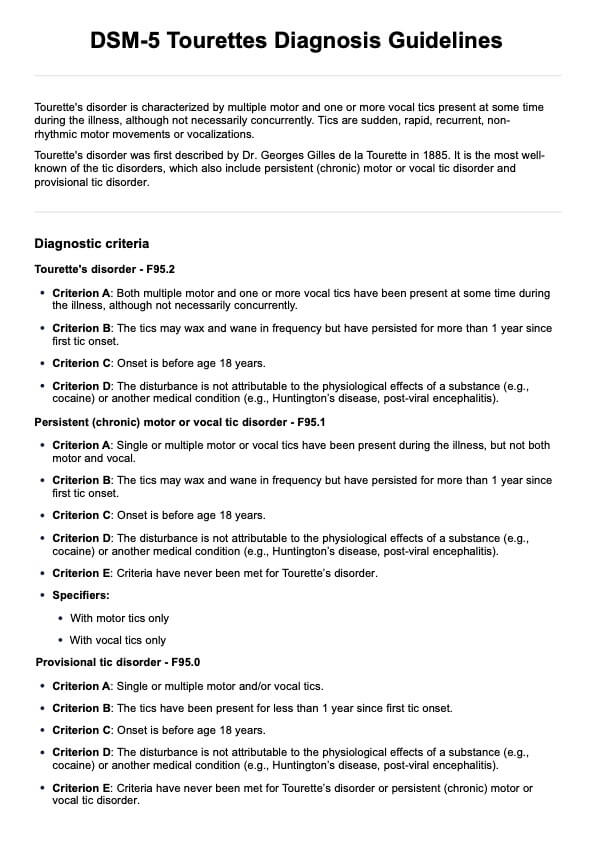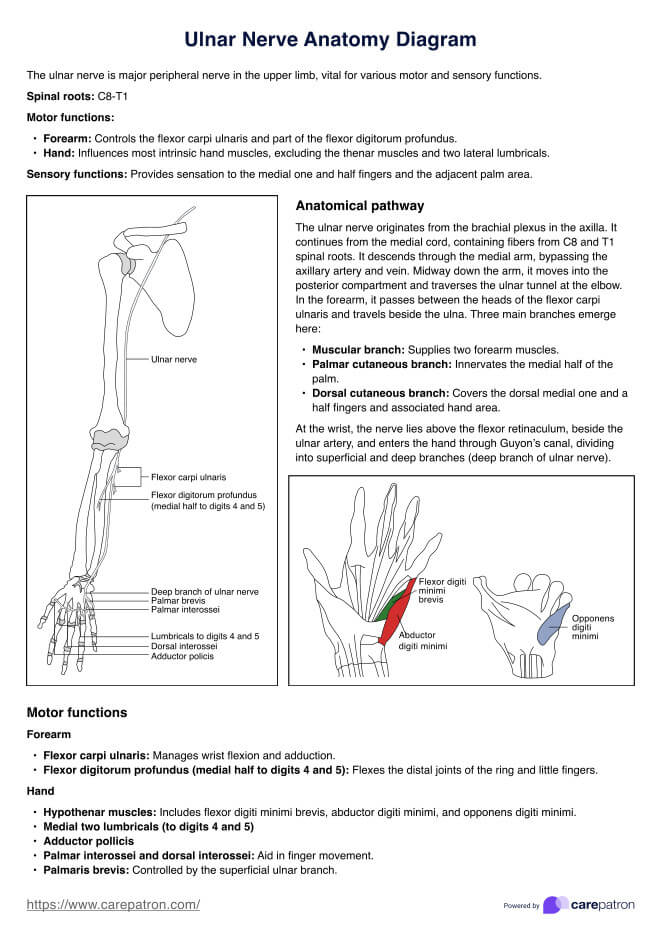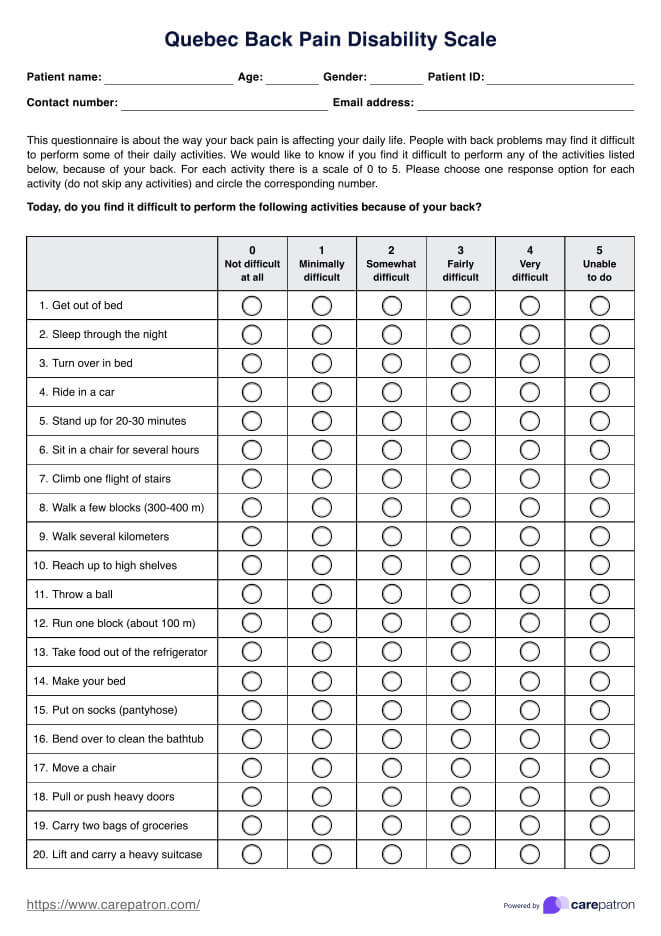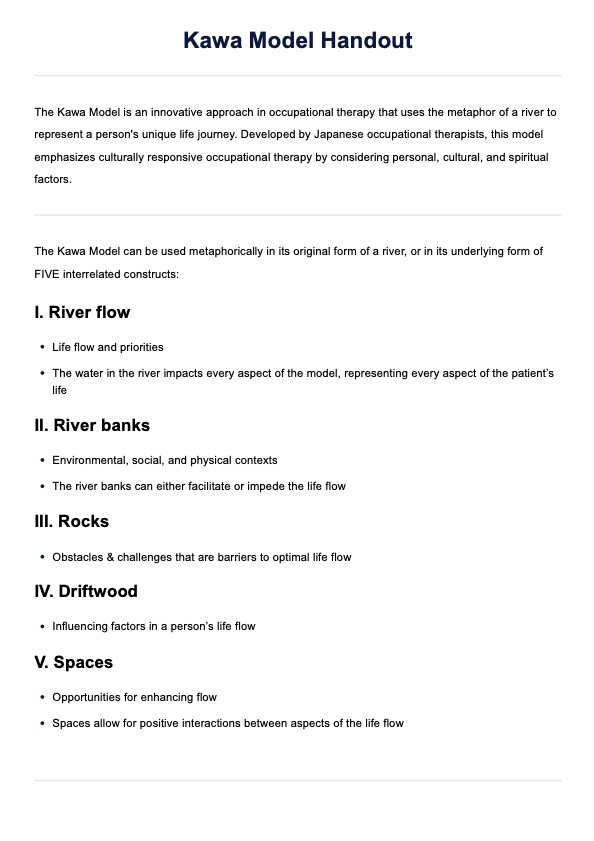Sacral Thrust Test
Learn about the Sacral Thrust Test, a diagnostic procedure for evaluating sacroiliac joint dysfunction and related lower back pain.


What is sacroiliac joint dysfunction?
Sacroiliac joint dysfunction is characterized by pain originating from the sacroiliac joints, which connect the sacrum (triangular bone at the base of the spine) to the spine and pelvis. This dysfunction often manifests as sacroiliac joint pain, contributing to chronic low back pain. Diagnosis typically involves sacroiliac pain provocation tests, such as the thigh thrust test, conducted during a physical examination.
During the thigh thrust test, the patient lies in the prone position while the examiner applies pressure to the back of the thigh, stressing the sacroiliac joints. If this maneuver reproduces the patient's pain, it suggests sacroiliac joint involvement. Other sacroiliac pain provocation tests may also be employed to confirm the diagnosis.
Symptoms
The sacral thrust test is a diagnostic maneuver used to assess sacroiliac joint dysfunction, and it doesn't have symptoms. However, individuals with sacroiliac joint dysfunction may present with various symptoms that can be evaluated through this test.
Common symptoms associated with sacroiliac joint dysfunction include:
- Lower back pain: Patients often experience pain in the lower back, particularly on one side, which may radiate into the buttocks or thighs.
- Hip pain: Discomfort or pain may be felt in the hips, especially when standing, walking, or transitioning between sitting and standing positions.
- Buttock pain: Pain in one or both buttocks is a frequent complaint among individuals with sacroiliac joint dysfunction.
- Pelvic pain: Pain may be localized to the pelvic region, often worsened with movements such as bending, lifting, or twisting.
- Limited range of motion: Stiffness or restricted movement in the lower back, hips, or pelvis can occur, affecting daily activities and mobility.
- Radiating leg pain: Some individuals may experience pain that radiates down the leg, mimicking sciatica symptoms, due to irritation of nearby nerves.
- Difficulty walking: Pain and discomfort may make walking or prolonged standing challenging, impacting overall mobility and quality of life.
- Pain with certain activities: Symptoms may worsen with specific movements or activities, such as climbing stairs, lifting heavy objects, or prolonged sitting.
Diagnosis
Diagnosing sacroiliac joint pain and dysfunction involves a comprehensive assessment, including a thorough medical history, physical examination, and specific diagnostic tests. During the physical examination, healthcare providers may perform sacroiliac pain provocation tests, such as the sacral thrust test, Yeoman's test, and Faber's test, to elicit pain and assess sacroiliac joint function.
Yeoman's test involves the patient lying prone while the examiner flexes the knee with one hand and extends the hip, stressing the sacroiliac joint. If pain is reproduced with this maneuver, it suggests sacroiliac joint dysfunction. Faber's test, also known as the Patrick test, assesses the mobility of the sacroiliac joint by positioning the patient in a supine position and placing the ankle of one leg on the opposite knee, then gently pressing down on the flexed knee to stress the joint.
Sacral Thrust Test Template
Sacral Thrust Test Example
What is the Sacral Thrust Test?
The sacral thrust test is a diagnostic tool healthcare professionals use to assess potential dysfunction in the sacroiliac joint or sacrum, a common source of chronic low back pain. The patient lies face down (prone) on an examination table during this test. The examiner then applies a controlled, anteriorly directed thrust (push) to the patient's sacrum, typically over the second sacral vertebrae.
The primary purpose and aim of the sacral thrust test is to provoke pain or discomfort in the sacroiliac joint region. If the patient experiences a reproduction of their usual symptoms when pressure is applied to the sacrum, the test is considered positive. This positive result suggests that the sacroiliac joint may contribute to the patient's lower back pain.
A positive sacral thrust test finding guides healthcare providers in developing a targeted treatment plan for the patient's sacroiliac joint dysfunction. This plan may incorporate various therapeutic interventions, such as physical therapy to improve mobility and strengthen core muscles, medication to manage pain and inflammation, or injections to relieve localized pain. In severe cases, surgical intervention might be considered.
Ultimately, the specific treatment approach will be tailored to address the individual's unique needs and optimize their recovery.
How to perform the test
Here are the steps in performing this test:
Step 1: Preparation
Ensure the patient is lying comfortably face down on a stable surface. Explain the test's purpose and potential sensations.
Step 2: Positioning
Stand beside the patient at hip level. Position your hands correctly over the patient's sacrum's spinous process for proper pressure application.
Step 3: Applying pressure
Apply gentle pressure forward on the sacrum using fingertips or palms. Maintain steady and controlled pressure without sudden movements.
Step 4: Observation
Observe the patient closely for any discomfort or pain during pressure application. Please encourage them to communicate any sensations they experience.
Step 5: Interpretation of results
Release pressure and ask the patient about their experience. A positive result, indicated by reproduced symptoms, suggests sacroiliac joint involvement.
Step 6: Documentation
Document findings, including areas of tenderness or pain, in the patient's records for future reference and treatment planning.
Step 7: Follow-up
Based on the results, decide on further evaluation or treatment. Follow up as needed to monitor progress and adjust management strategies accordingly.
Results and interpretation
The Sacral Thrust Test is valuable, but interpreting the results requires consideration alongside other tests and clinical findings.
- Positive test result: The test result is considered positive if the patient experiences a reproduction of their usual low back pain when pressure is applied to the sacrum. This suggests that the sacroiliac joint may contribute to the patient's pain. However, it's important to note that a positive Sacral Thrust Test alone isn't diagnostic of sacroiliac joint dysfunction.
- Negative test result: If the patient does not experience a significant increase in pain or reproduction of their usual symptoms during the test, the result is considered negative. This suggests that sacroiliac joint dysfunction is likely not the primary source of the patient's pain. However, a negative test doesn't rule out other potential causes of lower back pain.
Overall interpretation
The Sacral Thrust Test provides one piece of the puzzle in diagnosing the cause of low back pain. A healthcare professional will consider the test results, patient history, symptoms, and other clinical findings to arrive at an accurate diagnosis and develop an appropriate treatment plan.
Next steps
Following a positive Sacral Thrust Test result, a healthcare professional will work with you to create a personalized treatment plan specifically designed to address your sacroiliac joint dysfunction. This plan might encompass a combination of the following approaches:
- Physical therapy: A physical therapist can design a program of exercises and manual therapy techniques to improve mobility and strengthen the muscles around your sacroiliac joint. This can help stabilize the joint and reduce pain.
- Medication: Medications like pain relievers and anti-inflammatories can help manage pain and inflammation associated with sacroiliac joint dysfunction.
- Lifestyle changes: Simple lifestyle adjustments, such as practicing good posture and incorporating gentle exercises into your routine, can significantly improve symptoms and promote long-term joint health.
Regular follow-up appointments are crucial for monitoring your progress and ensuring an adequate treatment plan. This collaborative approach empowers you to actively participate in managing your sacroiliac joint dysfunction and achieve long-lasting pain relief.
Research and evidence
The sacral thrust test has a long history in orthopedics and physical therapy, initially developed to pinpoint the source of lower back pain. Ongoing research focuses on refining the technique and validating its effectiveness through clinical studies and observational data.
A 2020 review by Nejati et al. in the Journal of Chiropractic Medicine emphasized the importance of combining multiple tests, patient history, and clinical judgment to diagnose sacroiliac joint dysfunction accurately. Their findings highlight that no single test is definitive, but the sacral thrust test remains a valuable tool within a comprehensive evaluation.
Similarly, Telli's 2018 research, published in a peer-reviewed journal, investigated the validity and reliability of provocation tests, including the sacral thrust test, in diagnosing sacroiliac joint dysfunction. The study underscores the importance of a thorough clinical examination and choosing appropriate tests based on individual presentations. This research adds to the growing evidence supporting provocation and sacral thrust tests as valuable tools for diagnosing sacroiliac joint dysfunction.
Resources
Nejati, P., Sartaj, E., Imani, F., Moeineddin, R., Nejati, L., & Safavi, M. (2020). Accuracy of the Diagnostic Tests of Sacroiliac Joint Dysfunction. Journal of Chiropractic Medicine, 19(1), 28–37. https://doi.org/10.1016/j.jcm.2019.12.002
Telli, H. (2018). The Validity and Reliability of Provocation Tests in the Diagnosis of Sacroiliac Joint Dysfunction. January 2018, 1(21;1), E367–E376. https://doi.org/10.36076/ppj.2018.4.e367
Commonly asked questions
The patient lies in a prone position on an examination table during the Sacral Thrust Test. At the same time, the practitioner applies anteriorly directed pressure to the sacrum, typically over the spinous process of the second sacral segment.
The primary purpose of the Sacral Thrust Test is to test and provoke pain or discomfort in the sacroiliac joint region, helping clinicians identify potential dysfunction or pathology.
The Sacral Thrust Test may be indicated in patients presenting with chronic low back pain, particularly when sacroiliac joint dysfunction is suspected based on clinical history and physical examination findings.


